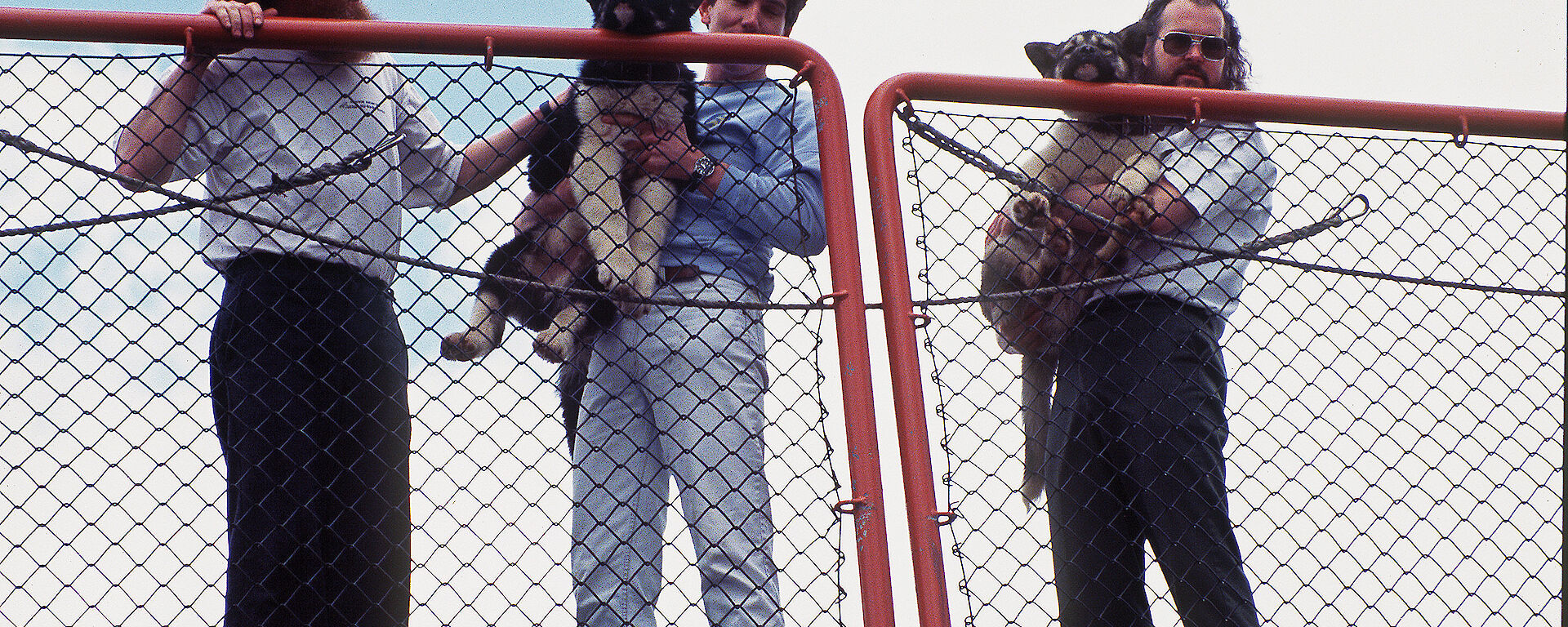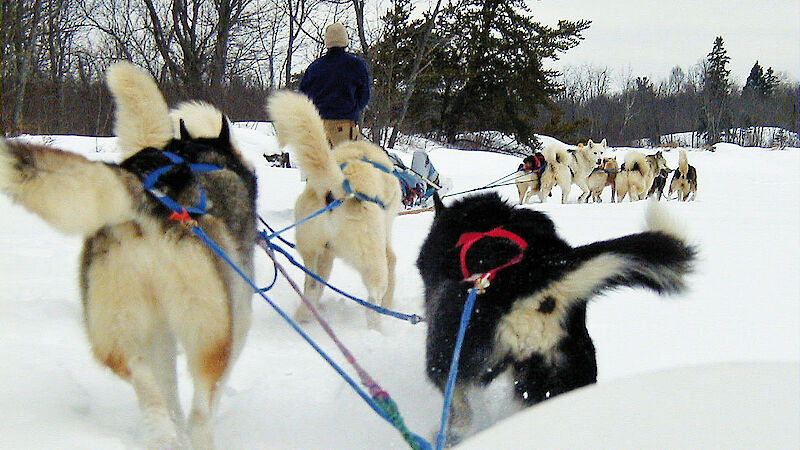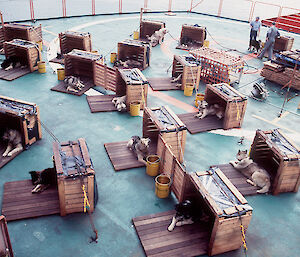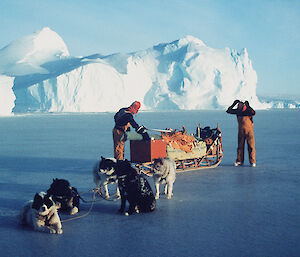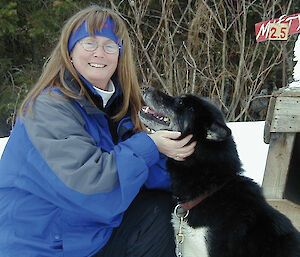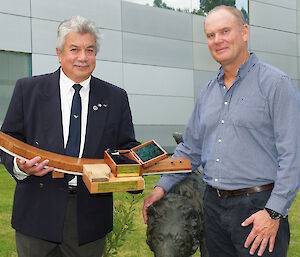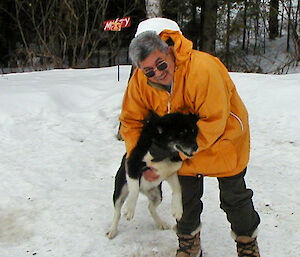Australian National Antarctic Research Expedition veteran Gordon Bain has been instrumental in returning one of the last Antarctic huskies to her birthplace, 19 years after her removal under the Environmental Protocol to the Antarctic Treaty.
The last litter of Antarctic huskies was born at Mawson station on Monday 10 August 1992. The three puppies were born to Cardiff and Cocoa and were named Cobber, Frosty and Misty. Huskies had been at Mawson since the station was established by Phillip Law in February 1954.
On Monday 23 November 1992 I was on the docks in Hobart with a bunch of other people, watching the RSV Aurora Australis returning from her first voyage to Antarctica for the season. As the ship got closer we saw, heard and smelled husky dogs on the heli-deck. These were the younger working huskies returning from Antarctica as a result of the eviction orders stemming from the Madrid Protocol.
Once the ship was secure the gathered media and everyone on the dock clamoured to see the dogs. A very special treat was seeing the three husky pups at the guard rails on the deck in the care of returning wintering expeditioners, Dave Pottage and Al Rooke, and glaciologist Tony Worby. For pups only 15 weeks old, they had all the characteristics of the ‘Mawson breed’ — much larger than other husky puppies.
The puppies and 19 adult working dogs left Hobart a day or two later on a flight to Los Angeles, followed by a long road journey to Ely, Minnesota, up against the Canadian border. A film ‘The Last Husky’ (Aurora Films) describes the huskies’ last sea ice trip across the ice along the coast to the emperor penguin rookeries and the 20 000km, two-week journey to Ely by helicopter, ship, aircraft and truck. The three pups and 14 of the adult dogs went to the Voyageur Outward Bound School; the other five adults went to Paul Schurke’s Wintergreen Lodge nearby. But that day on the Hobart docks was not to be my last encounter with Misty.
Eight years later, in March 2001, I went to Ely with an American school teacher friend, Betty Trummel, and one of her students. We had been in touch with the Voyageur Outward Bound School and learned that Misty was still there and working.
Our trip was memorable. The school’s Program Director Dave Backler and his staff very kindly hitched up two dog teams and our party took off on a wonderful sledging run through the forested lakes country. I went with the team that included Misty, who was now nine years old. Despite having seen huskies on the dog lines at Mawson over the years I had not had the opportunity to travel with them. Being able to do so with Misty in a place far removed from her birth place was a joy. It was hard leaving. We learned that the adult dogs that had gone to Ely in 1992–93 had either died or retired and even Misty’s siblings, Cobber and Frosty, had died.
I retired not long after that and began a significant involvement in Antarctic education programs in Tasmanian schools and a long association with the Midwinter Festival. But huskies were never far from my thoughts; they were a recurring theme in many of the talks I gave at schools and on occasions during the midwinter festivals.
In June 2009 the Australian Archives had an exhibit relating to huskies as part of that years’ Midwinter Festival. I was one of the volunteers looking after the school groups that came through the exhibit during the festival week. In preparation for the sessions I gathered sundry husky memories and artefacts, including snippets about the repatriation of the huskies, their life in North America and my own contact with Misty. Deb Barrett, a volunteer who brought one of the school groups through, said that she had recently been speaking with Dave Pottage and that Dave would have some further information about Misty.
I established contact with Dave and through him a contact with Frank Hashek in Indianapolis. Dave had met Frank at Ely years earlier when Frank was a participant on one of the Outward Bound courses. From Dave and then Frank I got the news that Misty had retired in late 2002 and that after negotiations with the Voyager Outward Bound School, Frank had taken Misty into retirement in Indianapolis in August 2003. Misty led a full and interesting life in retirement but sadly passed on 4 December 2007. She was cremated.
In one of my early contacts with Frank I raised the prospect of Misty’s ashes returning to Australia. He responded favourably saying also that ‘if they did indeed go to Mawson station, it would be as if Misty was going home’. Then began the slow process of getting appropriate parties ‘on board’ with the arrangement, sorting arrangements to get the ashes back, creating a suitable memorial and arranging for the ashes to go to their final homes.
Misty’s ashes arrived in Hobart on 27 January 2010, marking my third contact with her. Frank retained a portion of the ashes in Indianapolis, intending to scatter them in the forest and lakes country around Ely that was Misty’s home ground during her working life.
With encouragement and advice from many people, the support of the Tasmanian Polar Network and the Australian Antarctic Division, my friend Tony Adams and I set about creating two suitable memorial pieces — one to go back to Mawson, the other to remain in Hobart on public display.
The memorials comprise many elements reflecting not only Misty but also all other huskies that served with Australian expeditions in Antarctica:
- Misty’s ashes are in a velvet bag supplied by her last owners, Frank and Judy Hashek of Indianapolis, USA.
- The velvet bag is in a box made from myrtle (Nothofagus cunninghamii); a temperate rainforest species found extensively in Tasmania and in Antarctica’s fossil record.
- Part of the box sits on a portion of an original runner from a sledge pulled by huskies at Mawson, where they had lived and worked from the station’s founding in 1954 until their removal in 1992. The sledge runners were kindly supplied by the Australian Antarctic Division.
- The other part of the box sits on a block of North American timber representing the country in which Misty spent most of her life.
- Huskies were used at Wilkes from 1959. Dog operations ceased in the area when ‘old’ Casey replaced Wilkes in 1969. A piece of weathered timber, incorporated into the memorials, is a remnant from the tunnel of ‘old’ Casey station which operated until 1988 — the donor wishes to remain anonymous.
The memorials carry a plaque identifying Misty as The Last Mawson Husky and a second plaque with some words based on Robert Louis Stevenson’s ‘Requiem’:
Under the wide and starry sky,
Gladly did I live and gladly die.
Here she lies where she longed to be,
Home is the sailor, home from the sea.
Misty was returned to Mawson, in the care of Mawson Station Leader Mark Williams, in March this year, 19 years after she left.
GORDON BAIN
Australian Antarctic Division 1983–2001.
Gordon Bain made 12 voyages to Antarctica during an 18 year career with the Australian Antarctic Division. He visited Australia’s three Antarctic stations, Macquarie Island, Heard Island, the Bunger Hills and other field sites, as well as Dumont d’Urville, Zhongshan and Progress stations. During his trips he worked in voyage management and as a volunteer in various science programs. Since his retirement in 2001 he has been involved in Antarctic educational activities, including development of the Tasmanian Ice Boxes with American school teacher Betty Trummel, volunteering at the Tasmanian Midwinter Festival and membership of the Tasmanian Polar Network.

